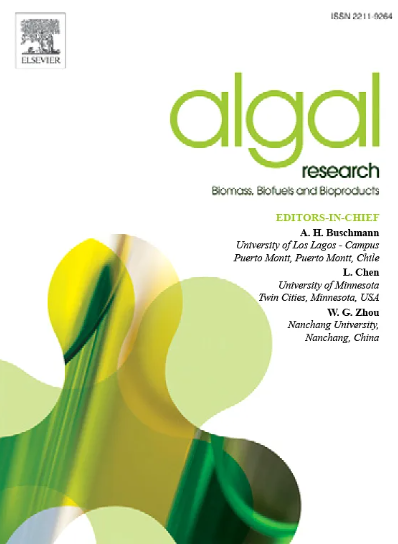Transcription factor MYB15 mediates docosahexaenoic acid biosynthesis and salt tolerance in Schizochytrium sp.
IF 4.6
2区 生物学
Q1 BIOTECHNOLOGY & APPLIED MICROBIOLOGY
Algal Research-Biomass Biofuels and Bioproducts
Pub Date : 2025-03-25
DOI:10.1016/j.algal.2025.104016
引用次数: 0
Abstract
Schizochytrium sp., a unicellular heterotrophic marine protist belonging to the thraustochytrids, serves as a commercial source of docosahexaenoic acid (DHA). Enhancing strain tolerance to environmental stress promotes strain robustness and productivity. Currently, we know very little about the transcription regulators that regulate DHA biosynthesis and abiotic stress response in thraustochytrids, which hinders strain improvement by transcription factor engineering strategies. In this study, we identified a 3R-MYB transcription factor, MYB15, which was transcriptionally downregulated under low-nitrogen condition in Schizochytrium sp. ATCC20888. Deletion of the myb15 gene increased production of total lipids and DHA by 27.1% and 46.7%, respectively. Under high salt condition, myb15-deletion mutant ΔMYB15 displayed stronger salt tolerance and higher biomass than parental strain or complementation strain CMYB15. Electrophoretic mobility shift assays (EMSAs), DNase I footprinting assays, and transcriptome analysis demonstrated that MYB15 bound specifically to the 6-bp element 5′-CNGTTR-3′ in upstream regions of target genes, represses transcription of fatty acid biosynthetic genes (dga1, fabD, fas, and pfa) and salt tolerance-related genes (sos2, sos3, and betA). Taken together, we demonstrated that MYB15 acts as a critical repressor for DHA biosynthesis and salt stress response. Deletion of myb15 generates a mutant with remarkable capabilities of DHA production and salt resistance, which make it a promising Schizochytrium strain for industrial application.

求助全文
约1分钟内获得全文
求助全文
来源期刊

Algal Research-Biomass Biofuels and Bioproducts
BIOTECHNOLOGY & APPLIED MICROBIOLOGY-
CiteScore
9.40
自引率
7.80%
发文量
332
期刊介绍:
Algal Research is an international phycology journal covering all areas of emerging technologies in algae biology, biomass production, cultivation, harvesting, extraction, bioproducts, biorefinery, engineering, and econometrics. Algae is defined to include cyanobacteria, microalgae, and protists and symbionts of interest in biotechnology. The journal publishes original research and reviews for the following scope: algal biology, including but not exclusive to: phylogeny, biodiversity, molecular traits, metabolic regulation, and genetic engineering, algal cultivation, e.g. phototrophic systems, heterotrophic systems, and mixotrophic systems, algal harvesting and extraction systems, biotechnology to convert algal biomass and components into biofuels and bioproducts, e.g., nutraceuticals, pharmaceuticals, animal feed, plastics, etc. algal products and their economic assessment
 求助内容:
求助内容: 应助结果提醒方式:
应助结果提醒方式:


